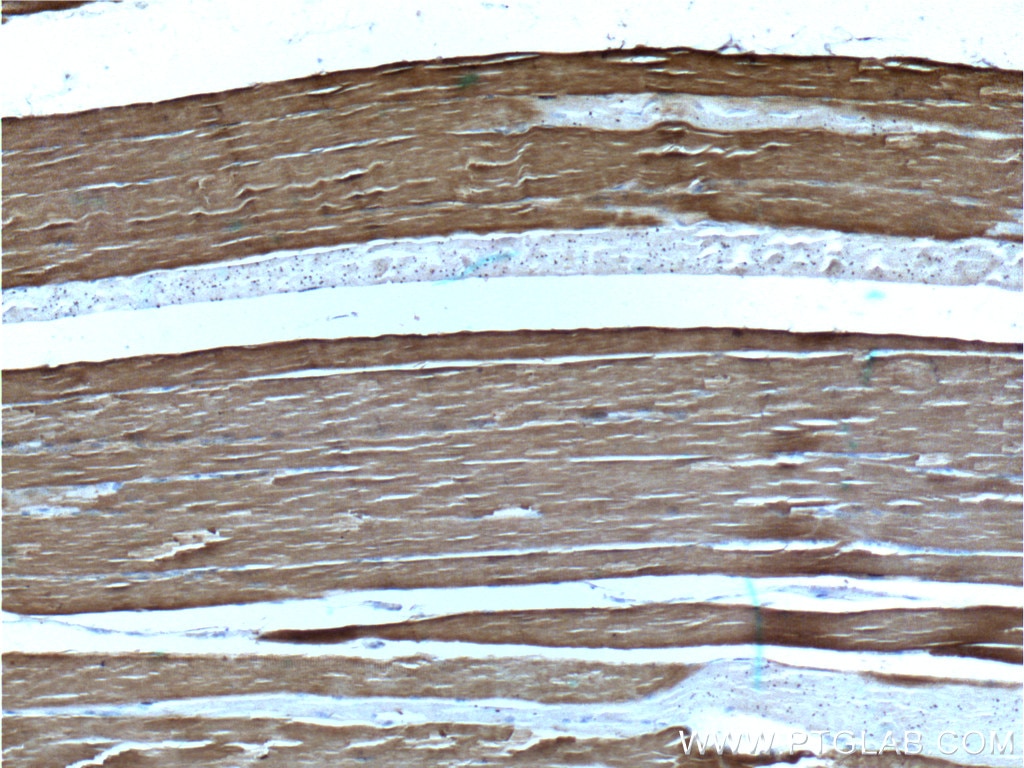Validation Data Gallery
Tested Applications
| Positive WB detected in | mouse skeletal muscle tissue, human stomach tissue |
| Positive IP detected in | mouse heart tissue |
| Positive IHC detected in | human skeletal muscle tissue, mouse skeletal muscle tissue Note: suggested antigen retrieval with TE buffer pH 9.0; (*) Alternatively, antigen retrieval may be performed with citrate buffer pH 6.0 |
| Positive IF/ICC detected in | U2OS cells |
| Positive FC (Intra) detected in | U2OS cells |
Recommended dilution
| Application | Dilution |
|---|---|
| Western Blot (WB) | WB : 1:500-1:2000 |
| Immunoprecipitation (IP) | IP : 0.5-4.0 ug for 1.0-3.0 mg of total protein lysate |
| Immunohistochemistry (IHC) | IHC : 1:50-1:500 |
| Immunofluorescence (IF)/ICC | IF/ICC : 1:50-1:500 |
| Flow Cytometry (FC) (INTRA) | FC (INTRA) : 0.40 ug per 10^6 cells in a 100 µl suspension |
| It is recommended that this reagent should be titrated in each testing system to obtain optimal results. | |
| Sample-dependent, Check data in validation data gallery. | |
Published Applications
| KD/KO | See 1 publications below |
| WB | See 7 publications below |
| IHC | See 2 publications below |
| IF | See 1 publications below |
Product Information
13504-1-AP targets TNNC1 in WB, IHC, IF/ICC, FC (Intra), IP, ELISA applications and shows reactivity with human, mouse, rat samples.
| Tested Reactivity | human, mouse, rat |
| Cited Reactivity | human, mouse, rat |
| Host / Isotype | Rabbit / IgG |
| Class | Polyclonal |
| Type | Antibody |
| Immunogen | TNNC1 fusion protein Ag4339 相同性解析による交差性が予測される生物種 |
| Full Name | troponin C type 1 (slow) |
| Calculated molecular weight | 161 aa, 18 kDa |
| Observed molecular weight | 18 kDa |
| GenBank accession number | BC030244 |
| Gene Symbol | TNNC1 |
| Gene ID (NCBI) | 7134 |
| RRID | AB_2256271 |
| Conjugate | Unconjugated |
| Form | Liquid |
| Purification Method | Antigen affinity purification |
| UNIPROT ID | P63316 |
| Storage Buffer | PBS with 0.02% sodium azide and 50% glycerol , pH 7.3 |
| Storage Conditions | Store at -20°C. Stable for one year after shipment. Aliquoting is unnecessary for -20oC storage. |
Background Information
Troponin is a central regulatory protein of striated muscle contraction, and together with tropomyosin, is located on the actin filament. Troponin consists of 3 subunits: TnI, which is the inhibitor of actomyosin ATPase; TnT, which contains the binding site for tropomyosin; and TnC, the protein encoded by this gene. TnC plays an important role in excitation-contraction coupling and is the primary target of compounds such as levosimendan that augment Ca2+ responsiveness of the thin filament.
Protocols
| Product Specific Protocols | |
|---|---|
| WB protocol for TNNC1 antibody 13504-1-AP | Download protocol |
| IHC protocol for TNNC1 antibody 13504-1-AP | Download protocol |
| IF protocol for TNNC1 antibody 13504-1-AP | Download protocol |
| IP protocol for TNNC1 antibody 13504-1-AP | Download protocol |
| Standard Protocols | |
|---|---|
| Click here to view our Standard Protocols |
Publications
| Species | Application | Title |
|---|---|---|
Nat Commun Calcium-dependent FAK/CREB/TNNC1 signalling mediates the effect of stromal MFAP5 on ovarian cancer metastatic potential.
| ||
J Proteome Res iTRAQ-based proteomic analysis reveals recovery of impaired mitochondrial function in ischemic myocardium by Shenmai formula. | ||
Front Cardiovasc Med GSK-J4, a Specific Histone Lysine Demethylase 6A Inhibitor, Ameliorates Lipotoxicity to Cardiomyocytes via Preserving H3K27 Methylation and Reducing Ferroptosis. | ||
Mol Cell Biol MUNC, an Enhancer RNA Upstream from the MYOD Gene, Induces a Subgroup of Myogenic Transcripts in trans Independently of MyoD. | ||
Onco Targets Ther LukS-PV Inhibits Hepatocellular Carcinoma Cells Migration via the TNNC1/PI3K/AKT Axis. | ||
Med Sci Monit TNNC1 Reduced Gemcitabine Sensitivity of Nonsmall-Cell Lung Cancer by Increasing Autophagy. |








